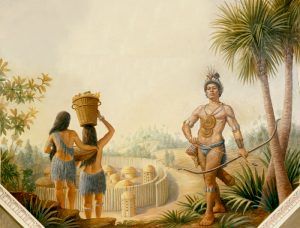The Acuera tribe were part of the Timucuan linguistic division of the Muscogean Family. Located at the headwaters of the Ocklawaha River in Florida, they were first noted by the Spanish explorer, Hernando de Soto, in a letter written at Tampa Bay to the Civil Cabildo of Santiago de Cuba.
De Soto described where they lived as being “a large town where with much convenience we might winter.” Though the Spaniards did not pass through the village, while they were at Ocale, they sent to Acuera for corn. The name appears later in French explorer, René Goulaine de Laudonnière’s narrative of the second French expedition to Florida in 1564-65, as a tribe allied with the Utina. Later, they were noted briefly in Spanish documents and in 1604, an encounter between the tribe and Spanish troops.
By 1655, there were two Acuera missions — San Luis and Santa Lucia, both of which had disappeared by 1680. The inland position of the Acuera is partly responsible for the few early descriptions of them. Later, the tribe was probably gathered into the “Pueblo de Timucua,” which stood near St. Augustine, Florida in 1736, and was finally removed to the Mosquito Lagoon and Halifax River in Volusia County. The tribe is entirely extinct today.
Compiled by Kathy Weiser-Alexander/Legends of America, updated July 2021.
Also See:

